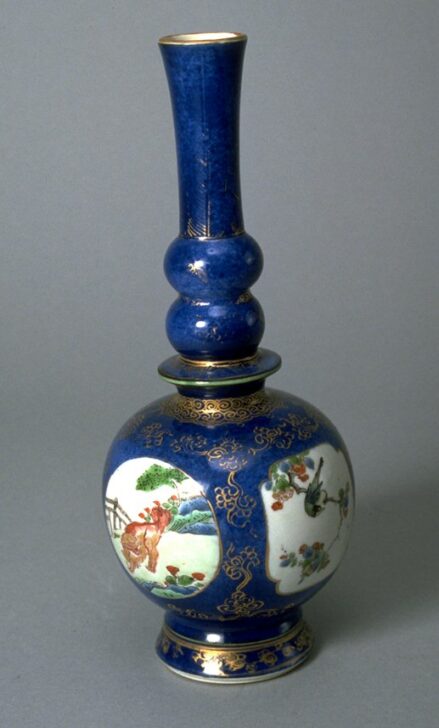Vase
Chinese

Description
Subject Matter:
A porcelain, powder blue bottle vase of the Kangxi reign (1662-1722) of the Qing dynasty (1644-1911). The imagery of qilin, lions, and birds among flowering branches all have auspicious meanings. Qilin are zoomorphic mythological creatures with a lion's head and a goat's body, and sometimes have a horn or horns and scales. They are auspicious creatures that represent Confucian ideals of benevolence, gentleness, goodwill and integrity. Lions, despite not being native to China are popular motifs in Chinese art. Their imagery was introduced along with Buddhism from Central Asia. They are often associated with having supernatural and protective powers. Birds on flowering branches, such as seen in two of the reserves, represent happiness, as the first character in the word for bird, xique, is xi, a homophone for happiness, while the word for prunus, mei, is a homonym for eyebrows. Thus the bird among flowering branches is synonymous with a wish for "happiness up to one's eyebrow's".
Powder blue, soufflé blue, snowflake blue or xue hua lan (雪花篮), sprinkled blue or sa lan (洒蓝), fish-roe blue (鱼子绿), and blown blue or chuiqing (吹青) are all terms used to describe a subset of famille verte porcelains that are covered with a cobalt blue ground comprising of many layered dots of various sizes, creating gradations in color. It was produced at Jingdezhen (景德镇), Jiangxi (江西), China for a very short time during the Kangxi (康熙) reign (1661- 1722) of the Qing (清) dynasty (1644-1912), primarily from about 1700-1722. It characterized by its rich, speckled cobalt underglaze surface covering the majority of porcelain vessel. Sometimes, reserves are masked off using paper as a resist, to keep some areas of the porcelain white. These areas may be decorated later with underglaze cobalt blue or underglaze copper red before glazing and firing, or possibly decorated with famille verte enamels and gilding after glazing and firing. The designs often featured scenes from classical literature, "five color blue" landscapes, birds and flowers, beautiful ladies, the "Hundred Antiquities", and auspicious objects and divine beings. The multiple firings and costly materials made powder blue wares extremely expensive to produce.
Physical Description:
This porcelain, bottle-shaped vase with globular body has a tall flaring footring. The tall, flaring neck, has a protruding flange below two globular bulbs at the lower portion of the neck. The body of the vase is covered in powder blue underglaze and has four reserves, two cirular and two rectangular, placed around the body. The white base has underglaze blue double circles, covered in a clear glaze. The round reserves are painted with polychrome overglaze enamels to depict a qilin and a lion in landscapes, alternating with images of birds among flowering branches in the rectangular reserves. The body of the vase is covered in powder blue ground with overglaze gold enamel floral sprays and banana leaf lappets around the neck. There is a paper label with "Chait Galleries New York" applied to base.
This vase is part of a ten-piece garniture set which includes: jars, 1982/1.206A, 1982/1.206B, 1982/1.206C, 1982/1.207A, 1982/1.207B, and 1982/1.207C; vases, 1982/1.208, 1982/1.215, 1982/1.216, 1982/1.220; plates, 1982/1.212, 1982/1.213, and bowls 1982/1.221,1982/1.22.
Usage Rights:
If you are interested in using an image for a publication, please visit https://umma.umich.edu/request-image/ for more information and to fill out the online Image Rights and Reproductions Request Form.